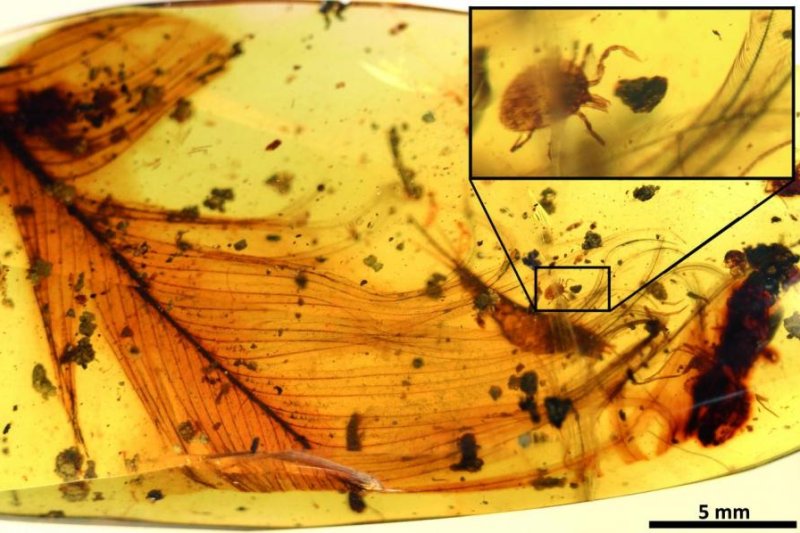A tick was found grasping the strands of a dinosaur feather in a piece of ancient amber. Photo by Cambridge University
Dec. 12 (UPI) -- Newly unearthed amber fossils have proven prehistoric ticks were feeding on feathered dinosaurs 100 million years ago.
A so-called hard tick, found in one of the pieces of ancient amber, is the oldest specimen of its kind. The amber fossil revealed the tick clutching the strands of a dino feather and still has the blood of its last victim in its stomach, a rarity.
Though the discovery recalls the movie Jurassic Park, previous studies have shown DNA molecules to be too fragile to survive for millions of years inside the abdomen of an insect. Still, the find -- detailed this week in the journal Nature Communications -- offers fresh insights into the Cretaceous period, from 145 to 66 million years ago.
"Ticks are infamous blood-sucking, parasitic organisms, having a tremendous impact on the health of humans, livestock, pets, and even wildlife, but until now clear evidence of their role in deep time has been lacking," study author Enrique Peñalver, a researcher with the Spanish Geological Survey, said in a news release.
The fossils offer the earliest example of the tick-feathered dinosaur parasite-host relationship. As revealed by the fossilized tick, the structure of dinosaur features from the period was similar to those of modern-day bird feathers.
"The fossil record tells us that feathers like the one we have studied were already present on a wide range of theropod dinosaurs, a group which included ground-running forms without flying ability, as well as bird-like dinosaurs capable of powered flight," said study co-author Ricardo Pérez-de la Fuente, a research fellow at the Oxford University Museum of Natural History.
Another amber fossil revealed a species dubbed "Dracula's terrible tick." The engorged tick is eight times its normal size, filled with dinosaur blood. Evidence suggest the tick's victim was also a feathered dinosaur.
"Assessing the composition of the blood meal inside the bloated tick is not feasible because, unfortunately, the tick did not become fully immersed in resin and so its contents were altered by mineral deposition," said co-author Xavier Delclòs, researcher at the University of Barcelona.
The descendants of feathered dinosaurs were the only group to survive the mass extinction that wiped out the dinosaurs 66 million years ago -- providing the lineage that yielded all modern birds. But as the new research proves, ticks thrived throughout.
"The simultaneous entrapment of two external parasites -- the ticks -- is extraordinary, and can be best explained if they had a nest-inhabiting ecology as some modern ticks do, living in the host's nest or in their own nest nearby," said co-author David Grimaldi, researcher at the American Museum of Natural History.















